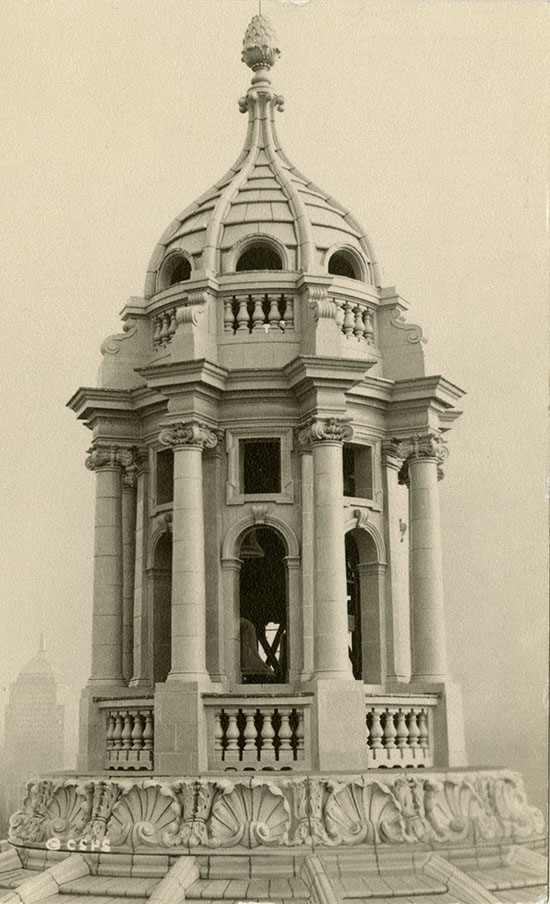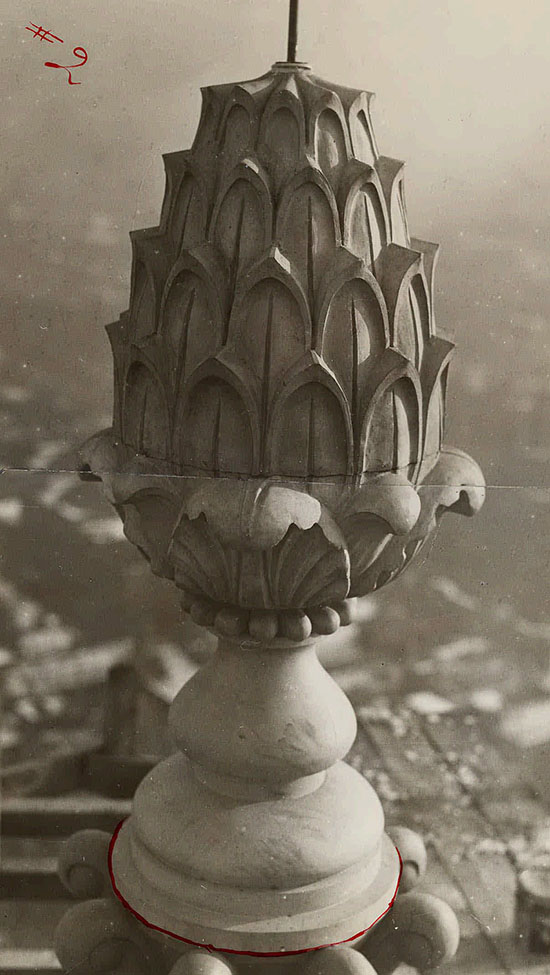Is The Mother Church’s finial a pineapple or a pine cone?
Above the main dome of Extension of The Mother Church is a 35-foot cupola.1 At the very top, 224 feet above the ground, is a finial—defined as “a distinctive ornament at the apex of a structure.”2 Sometimes people have said this finial is a pineapple. Sometimes a pine cone.

Cupola of the dome of The Mother Church, 1951, P08267. © The Christian Science Publishing Society.
The Mother Church Extension was built between 1904 and 1906. Charles C. Coveney, the architect’s chief assistant on the project, recalled that “the finial on the cupola in the earlier studies is a pineapple. In some drawings made during the period of construction a cross was substituted; in the end the pineapple form prevailed.”3In 1932 the church’s original limestone and terra cotta finial was replaced with an aluminum one. A 1933 article in the Christian Science Sentinel provided details, stating that the “pineapple design is commonly regarded as representing hospitality and immortality.”4
“View of aluminum pineapple placed on top of dome of The Mother Church on December 20, 1932,” 3 April 1939, P08265. George L. Sleeper.
Then in 1962, an article in The Christian Science Monitor provided some interesting information. The newspaper’s “Reader Asks” column printed a question: “I understand the pineapple over the doors and on churches stands for welcome and hospitality. Will you please tell me how this originated and where it was first used?” This was the answer:
Webster gives pineapple as another name for the pine cone—the apple or fruit of the pine. The architectural finial that most people call a pineapple is found in the early art of Egypt, Etruria, and Greece, centuries before the juicy fruit of Hawaii was known to the Western world. In pagan times the pine cone or pineapple design was considered a symbol of regeneration, taken from tree worship. Carried over into Medieval and Renaissance architecture, this became a symbol of immortality. The architectural finial, therefore, is actually a pine cone, but is usually given the name pineapple in the earlier and fundamental meaning of this word. We have so far found no source for an association with the idea of welcome or hospitality, however, it is certainly in the attraction implicit in the beautiful message of immortality. 5
The sources of this Monitor article are unclear, and it appears not to be entirely accurate.6 While the filial might have historic and architectural connections to the pine cone, both Coveney’s recollection and the perceptions of this architectural symbol in the 1930s strongly suggest that its connection is with the tropical pineapple.
- Charles C. Coveney, “The Designing and Building of The Mother Church Extension,” 11 January 1934, Reminiscence, 29
- Joseph Armstrong and Margaret Williamson, Building of The Mother Church (Boston: The Christian Science Publishing Society, 2009), 149.
- Coveney, “The Designing and Building of The Mother Church Extension,” 29.
- “Items of Interest,” Christian Science Sentinel, 21 January 1933, 411, https://sentinel.christianscience.com/shared/view/2gzqnouwerq?s=t.
- “The Reader Asks,” The Christian Science Monitor, 28 June 1962, 9.
- “The Mansion of a Harrison,” St. Louis Dispatch, 27 June 1901, 7.

